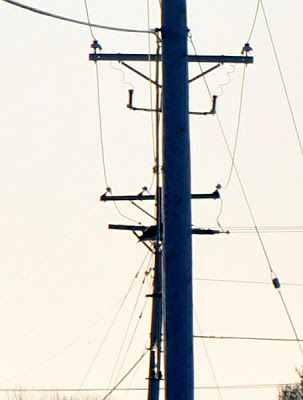
Photo courtesy of palemale.com
Pale Male, premier urban hawk, readies himself for sleep. He, as we know, is not in the least bothered by observing humans.

On the other hand, though I'm quite far away from the above power line, which only a moment ago had a beautiful rural Red-tailed Hawk, the Tall Grass Prairie female to be specific, perched on said wire, upon sighting me she was off like a rocket. This pair is good when it comes to diversions and obscuring themselves, hence why you've not seen them before. I try; they win.

Typically off she goes INTO the light which dazzles my eyes.

I saw her curve this direction but was so dazzled I couldn't catch where she went and had to wait until I got home to see what she was up to.

Can you see her?

Now? See her tail below the second cross bar. She's hunting late in the day and I don't want to bother her so I don't try again. Perhaps one of these days she'll get used to me. Maybe. But she has an entire territory to retreat to if she must and I'm only able to look from 1 or 2% of it. She doesn't have to get used to me to make her living.
FROM JEFF KOLLBRUNNER, www.jknaturegallery.com/ A CHIEF WATCHER OF MAMA AND PAPA
Donna,
Congratulations to Mama and Papa-The first over night of the season as far as I know, but then again, Mama and Papa often take get the earliest start on a family each year. All the best!

Photo Courtesy of the U.S. Fish and Wildlife Service
America's oldest wild bird mom (that we know of anyway D.B.) has a new chick.
(And she's looking really good besides. Just check out those fine feathers!)
"She's at least 60 years old, flies some 50,000 miles a year, has had almost three dozen kids – and now she's got another one."
http://news.blogs.cnn.com/2011/03/09/americas-oldest-wild-bird-is-a-new-mom/
To see video of an urban Screech Owl just before fly out, and hear its trill go to James O'Brien's blog http://yojimbot.blogspot.com/
Happy Hawking!
Donegal Browne





















